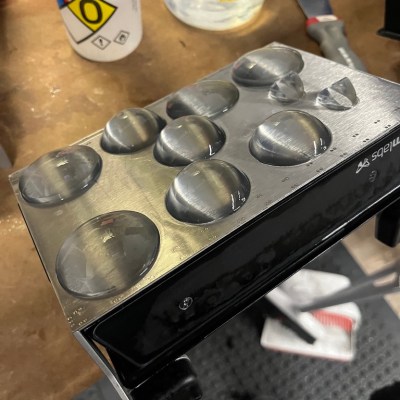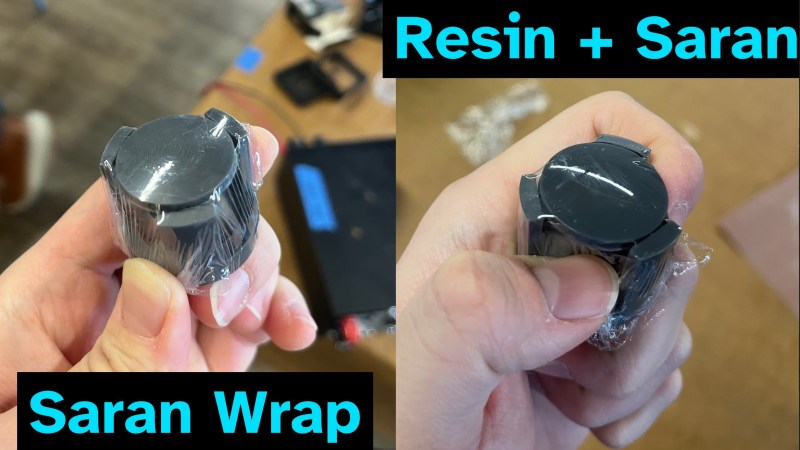This technique shared by [Andy Kong] is for 3D printed lenses, but would probably be worth a shot for any resin prints that need to be made nice and clear. The link to his post on X is here, but we’ll summarize below.
It’s entirely possible to print lenses on a resin printer, but some amount of polishing is inevitable because an SLA print still has layer lines, however small. We have seen ways to minimize the work involved to get a usable lens, but when it comes right down to it the printing process creates tiny (but inevitable) surface imperfections that have to be dealt with, one way or another.

One technique involves applying a thin layer of liquid resin to the surface of the printed lens, then curing it. This isn’t a complete solution because getting an even distribution of resin over the surface can be a challenge. [Andy] has refined this technique to make it ridiculously simple, and here’s how it works.
After printing the lens, place a drop of liquid resin on the lens surface and stretch some cling wrap over the lens. The cling wrap conforms to the shape and curve of the lens while trapping a super thin layer of liquid resin between the cling wrap film and the lens surface. One then cures the resin while holding the cling film taut. After curing, [Andy] says the film peels right off, leaving an ultra-smooth surface behind. No tedious polishing required!
But what about the flat back of the lens? [Andy] suggests that instead of using cling film (which is better at conforming to a curved surface) simply use a drop of resin in a similar way to bond the flat side of the lens to a smooth piece of glass. Or bond the backs of two lenses together to make a duplex lens. This technique opens quite a few possibilities!
Even if one isn’t 3D printing optical lenses, we suspect this technique might be applicable to making crystal-clear 3D prints with a little less effort than would otherwise be needed.
Keep it in mind, and if you find success (or failure!) let us know on the tips line because we absolutely want to hear about it.
















I love seeing all these 3D printing innovations. Genius!
It might be possible to adapt this technique to concave lenses by creating a seran wrap bag that can be pressed into the lens
I was wondering about simply putting some of the liquid on the cling film and twisting it to make a clear ball or perhaps loosely stretching the film over a ring and adding the liquid, letting the weight of the liquid form the lens shape, the back should be nice and flat by default as long as the ring is level.
Or print the complement convex form, stretch the film over it and use it to press the cling film into the concave lens.
“Vacuum pack” the cling film to a concave lens.
Or juste rotate a container of resin before curing it.
https://en.wikipedia.org/wiki/Liquid-mirror_telescope
I was thinking spin coating while reading the article as a way to do a convex shape, but I think you’re on to something when it comes to forming a parabolic mirror without needing to start with a print at all.
I’m fairly certain there was a Scientific American column decades ago describing exactly this as a way of making parabolic dishes from epoxy.
Vacuum bagging may work, but perhaps pressing down a balloon onto the surface is an easier solution.
Use a complementary shape. A convex lens which has been smoothened by the above technique to press the wrap on to the concave surface. Perhaps?
I look forward to reading about stepper motor driven turntables. Add a few drops to a spinning lens, and let centrifugal force create a concave surface.
Or a convex one, if you can get the resin to float on a liquid that’s denser and immiscible? A use for that mercury that we’ve all squirreled away?
I gave mine away to a gold miner several years ago. I have no idea what happened to the 2 cubic inches or so in a glass jar that I had when I was a kid.
See, liquid lens telescope.
I’d be curious how that will need to be adapted to concave or convex surfaces: ‘spin coating’ is absolutely a thing for applying thin films to flat surfaces(and, given that the semiconductor guys use it for applying resists for photolithography), accuracy and repeatability must be pretty decent.
Ironically the reason cling wrap works for this is for the same reason it doesn’t work so well for keeping food fresh anymore. Specifically, the fact that they switched to polyethylene.
Care to elaborate on why polyethylene film doesn’t keep food fresh?
I’m guessing he’s suggesting that polyethylene doesn’t stick to the edges of bowls and form an air tight seal.
Gas diffuses through the thin polyethylene film using in today’s products. Saran Wrap used to be polypropylene, and thicker.
Sara Wrap used to be made of Saran — polyvinylidene chloride.
Buy yours from a restaurant supply store instead, it’s usually thicker cheaper and bigger rolls
This is a good hack. Love it!
I wonder whether there’s a strategy like this that could be applied to Fresnel lenses.
I’ve just sprayed my 3d printed lenses with some clear coat. Works great in my experience.
The more the clear coat’s refractive index (when cured) differs from the print material’s, the more the “halo distortions” will be apparent in your finished lens. (Where you have a thicker toroid of clear coat in the corners of the steps in the print.)
Hello, my name is Kevin, I’m seeking someone to commission from a 3d printed optical lens adapter that fits on the front of the lens. Specifically, I’m looking to turn my 1000mm f/4.8 projector lens for my 24×32″ Mammoth format size camera into a fisheye with an adapter, like those you can buy for contemporary lenses. I’m a visual fine artist in Toronto, Canada, and I’ve love to chat with you.
If you’re interested, please contact me at toyo8x10@gmail.com.
Thank you for reading this.
This is a great idea. I do wonder though, what about the inhomogeniety between layers? Is that not an issue for DLP printers?
Oh my god that’s simultaneously genius and INCREDIBLY annoyingly simple, and clearly I’ve made lenses before and been here before to try and find a quick, simple and repeatable way to do this.
oh my god.
Why not take a mold off a high quality lens then cast copies?
Has anyone building polymer lenses this way measured the scatter from tiny internal stresses and density variations? How does this compare with grinding a lens from bulk polymer?
Is the quality good enough for eyeglasses? If so, then someone should be able to create a tool where you can enter your prescription and get a .stl file to print your own lenses.
Hello, my name is Kevin, I’m a visual fine artist in Toronto Canada.
I’ve had the desire to acquire a 3d printed fish eye (front of lens) adapter for my massive view camera lens.
The the lens is around 9.5 inches in diameter with a length of around 11 inches. The focal length is 1000 mm and the maximum f/stop is f/4.8.
If anyone reads this and think they would love to attempt to 3d print optical lenses, I would love to commission from you this fish eye adapter for my 24″by32″ view camera.
Please contact me at toyo8x10@gmail.com
Thanks so much for reading this.
Be well